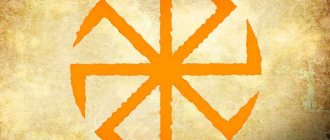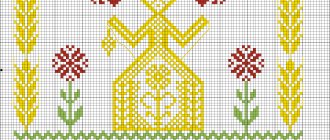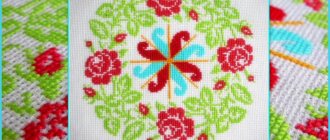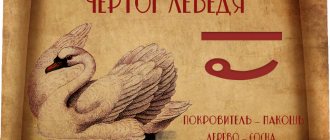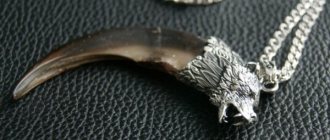Makosh in Slavic mythology is the Goddess of Fate. She patronizes women's crafts and magic. In the culture of any ancient people there is a phenomenon of protective jewelry, which was usually dedicated to the cult of one or another deity. There are so many such amulets in ancient Slavic culture that it is difficult to simply count them.
Some of these amulets are independent, some are auxiliary and additional, but this does not detract from their significance for us. The goddess Mokosh, like other Slavic deities, has her own amulet of the same name.
There is a dubious claim that the Makosh amulet is exclusively a female amulet. This entire statement is based only on the fact that this amulet is a way to “connect” to the creative and creative energy of the universe, which supposedly only a woman can comprehend.
Makosh - a talisman of the Slavic goddess
The Makosh amulet was used by representatives of the fair sex back in the days when our ancestors professed paganism. From time immemorial, it was considered a female symbol that protected a woman from troubles, bestowed family happiness, prosperity at home, harmony in relationships with her spouse, and the well-being of children.
Makosh is a goddess who was revered not only by women. She was responsible not only for family happiness, but also patronized farmers. This goddess personifies the fertile earth, she is what gives life to all living things and can be restored in the spring, after a cold winter that is deadly for all living things. Makosh is the Great Mother, the giver of life.
In the old days, she was worshiped near springs and wells, some of which are considered shrines to this day. At the same time, yarn was donated to the goddess. She was considered a brilliant weaver, but she did not spin threads, but the destinies of all people living on Earth. In this, Mokosh is helped by two sisters - Dolya and Nedolya, who, with the help of threads and scissors, measure the life span and fate of people in general.
According to legend, Makosh sometimes walks around the world in the guise of a young girl with long flowing hair. She asks those she meets along the way - do they observe the traditions of their ancestors? If a person lives in accordance with the ancient covenants and has a clear conscience, she sends the goddess of luck Srecha to such a person.
And if he has forgotten about his roots and does not honor his ancestors, Makosh will send to him Dashing One-Eyed, Nesrecha and Difficult, who will bring him difficulties until the person remembers the behests of his ancestors.
In addition, Makosh was considered the patroness of crossroads. Her cult was widespread, unlike Perun, who was more revered during the war. In general, Makosh is the goddess of femininity, life and fertility, the archetype of the Great Mother, as well as the creator of human destinies. During early Christianity, she began to be identified with Saint Paraskeva Friday.
Protective properties of the amulet
Lunnitsa pendant
The lunnitsa was worn to connect the energy of man and the energy of the gods. It is used for the following purposes:
- for the fertility of man and earth;
- to strengthen marriage relationships;
- for the ability to discover something new;
- for peace (reduce violent emotions, increase sensuality);
- to eliminate gynecological diseases;
- for protection from the evil eye, damage.
The last direction was especially important. The fact is that women are more easily influenced by dark magicians, because such a gift of nature as intuition has deprived them of a reliable protective aura.
Important! It has been observed that women who wear the Lunnitsa become objects of desire for men. They radiate charm and sexual magnetism. And they have a simply fascinating effect on the man they love.
The women's amulet Lunnitsa is able to protect against all actions of otherworldly forces, including night spirits, which are usually active in the moonlight. Today, interest in this amulet is being revived.
- Firstly, it looks very bright and unusual, attracting everyone’s attention.
- Secondly, it helps to cure diseases of the reproductive system, which are widespread among young girls today.
- Thirdly, Lunnitsa protects from the evil eye and envy.
Myths about the Goddess
The hands of the Goddess Makosh created the threads of destinies not only of people, but also of other Gods. In some legends she is mentioned as the wife of Veles, but this is erroneous.
The Goddess is always calm, because you can only look at and decide destinies with such a look. If they ask the Goddess for advice, they always listen to it, no matter who asks - a person or God. If a person is kind and brave and ready to fight adversity, Makosh will help him. If fate is lost, then Makosh has the power to return it to the path of Rule or God.
Myths say that the Spinner of Fate interferes with the share only in cases where it will not harm the overall fate of this world.
Perun's wife
According to one version, Makosh was the wife of the supreme Slavic god Perun. At the same time, she played one of the key roles in the myth of the creation of the world. On the other hand, she was often brought to the forefront as the central figure of the cult of pre-Christian Rus', opposed to the “retinue” Perun.
It is not surprising that Makosh was mainly popular with women. At the same time, she was considered not only the goddess of fate, but also of fertility and prosperity in general.
There is also a version that this deity came from Mordovia, since her name is similar to the name of one of the two main peoples who live there, Moksha.
Mokosh symbol for amulet - meaning
The meaning of the Makosh amulet makes it more suitable for women than for men. Initially, it was a female symbol, but sometimes it was also worn by farmers whose income depended on fertility. However, it was the woman who was considered the receptacle of creativity, the keeper of the hearth and the creator of life.
In the old days, the Slavic amulet Makosh was embroidered on the clothes of little girls. Unmarried girls also revered this goddess, asking her for the speedy arrival of matchmakers and happiness in family life. Married women wore the amulet of the Slavic goddess Mokosha to receive her help during childbirth, as well as a prosperous family life and harmony in relationships with their spouse.
The Makosh amulet is perfect for any girl. It can be given to a little daughter for protection from evil people and other troubles. An unmarried girl will find her betrothed faster and grow up to be a good housewife if she wears such an amulet.
After marriage, it is worth wearing to promote family happiness and prosperity. It also helps pregnant women, facilitating childbirth and promoting the birth of a healthy baby.
Since Makosh was also considered the patroness of female witchcraft, if you are interested in the occult or simply want to develop your intuition, it is worth acquiring such a talisman, as well as studying more about the cult of this goddess - she will help you find your path.
The meaning of the Mokosh symbol is often compared to a sown field - when everything is ready for harvesting, all that remains is to make an effort and get what you need. The four parts of this field can also represent the four elements, as well as the main components of man according to the Slavs - Conscience, Spirit, Soul and Body.
Rules for creating a protective doll
The rag symbol of Mokosh was made according to special rules. During the making of the goddess, the scraps were twisted and the threads were wound. Knots were used out of necessity; women were afraid to tie the knot. That is why the amulet dolls were called motankas.
The process of creating Mokosh was akin to birth. In the old days, dolls were considered animated, capable of experiencing various emotions. Therefore, the needlework that had begun could not be put off; Makosh had to finish it to the end. Abandoning a job was considered a bad omen that could bring great misfortune.
During production, the doll was not pricked with needles or cut with scissors. It was prohibited to touch the amulet with piercing objects. Weave the protector in a good mood, in good health, telling the guardian about the family in which she will live. It was believed that divine energy would not fill the motanka until the Makosh doll learned of its purpose.
During needlework, the craftswoman remained alone; nothing should interfere with the creation of the goddess. The moment of weaving was considered special; it was not for nothing that the woman plunged into a kind of trance state, renouncing everything earthly and focusing only on her dreams and desires. Everything that the needlewoman was thinking about at that moment was transmitted to the Makosha doll, this inhaled protective energy into it and tuned it to the wave of the owner of the talisman.
Amulet Makosh - how to embroider the symbol of the Slavic goddess
If you don’t really like embroidery and handicrafts in general, you can simply buy jewelry or clothes with the Mokosh sign. It is advisable that the jewelry be made of silver. It will have to be cleaned and charged, but more on that below.
If you want to make a talisman with your own hands, you should remember that the embroidery will look different from the pendant. It is customary to embroider Makosh herself, and the symbol should either depict her head or be located above it. Makosh is always depicted with a spindle; this is an invariable attribute of the goddess.
Embroidering the Mokosh sign, the significance of which in the role of women cannot be exaggerated, relies on the waxing moon or the full moon. This goddess does not like people who are weak in spirit and tired of life, so it is advisable to be in a joyful and happy mood. While embroidering, you should not tie knots or cut threads with scissors. In the process, you can read the conspiracy addressed to Mokosh:
You are a goy, Mother Makosh! Mother Makosh, a joy to all people! Sanctify my share! Remove grief and all misfortune and torment from the path! My thread is even, and my share is full of happiness! Both in the field and in the house!
If you like to do handicrafts, listen to music or look at the TV screen, you will have to forget about this while creating the amulet. You should only be focused on creating the magic item. Don't be distracted by conversations, phones or TV.
The background of the embroidery should be green or white. In the second case, there must be a green frame around the image. The embroidery should contain ears of corn - a symbol of prosperity and fertility. Suitable colors for embroidery are green, red and yellow. Flowers can be embroidered with blue threads.
You cannot use white threads for embroidering amulets. Older women can embroider with black thread. After creating the amulet, you can sprinkle it with spring water for consecration, and after that you can use it the way you intended. As a rule, such amulets are kept in a visible place at home or worn on clothes.
Selection of materials
Only natural fabrics and threads were used for the doll. Synthetic materials cannot be animated; there is no natural energy in them. They tore old clothes into shreds, which fully absorbed the energy of the owners. When it was necessary to cut out parts, this must be done in advance. If used fabric was used, it was necessary to ensure that it belonged to a happy person.
The choice of color was at the discretion of the craftswoman, but the traditional color of thread for fastening parts is red. Mokosh’s outfit deserved special attention. The doll's clothes are in the old Slavic style. It was sewn separately - the warrior was decorated with beads, the apron was cross-stitched, and lace was sewn to the hem. Spikelets, dried flowers, and small ears of corn could be used for decoration.
Charms with the sign of Mokosh - how to care for them
All amulets require periodic cleansing, and the Makosh amulet is no exception. If you haven't embroidered yours yourself, you'll need to clean it before using it. The best option would be water from a spring or well - Makosh was considered the patroness of water sources. How to clean a new amulet? Leave in water for a while or, if this is not possible, sprinkle with it.
From time to time you will have to cleanse your amulet. There are no specific deadlines here, it all depends on the amount of negativity that will be reflected by the magical object. It is believed that the owner of such an amulet herself will understand when the time comes to cleanse it of accumulated negativity. Look at the amulet more often, hold it in your hands, and your intuition will tell you when the time for cleansing comes.
Purification is carried out under the influence of three elements - air, water and fire. First, you should hand wash the embroidered fabric using baby or laundry soap. After washing, it should be dried near an open fire or in the sun.
This fabric cannot be washed in a machine; such washing will only provide mechanical cleaning of ordinary dirt. However, not everyone likes hand washing, so it can be done after machine washing - it will take less time. The pendant or other decoration should be held under running water and then placed in the sun to dry from the drops.
If the amulet is cracked, the embroidery has spread, or other damage appears, this means that its mission is over. Now it should be burned, floated down the river or buried in the ground. You cannot leave the Mokosh sign so that another person gets it - problems will begin to haunt both him and the owner of the amulet.
Activating the talisman and caring for it
The amulet is charged during its manufacture, so it is important that during the embroidery process the craftswoman is in a good mood and does the work in high spirits and with pure thoughts in the sunlight. The finished fabric must be washed by hand and dried in the sun.
Makosh is often performed or worn together with Lunnitsa - the amulets have similar meaning and power, so they can be used in tandem. It is not necessary to combine symbolism in embroidery or a body sign; their joint use is enough - they can strengthen the charge of positive energy attracted into the life of the owner.
To ensure that the amulet does not lose its protective functions and always attracts joy and happiness to the family, it is necessary to periodically subject it to a cleansing ritual.
The talisman is capable of accumulating environmental and personal negativity, this interferes with its stable operation and the production of positive energy.
If the amulet with the symbolism of the goddess is made as a decoration, complex manipulations are not needed - you just need to clean it with salt or cold spring water. The talisman should be immersed in salt and left overnight, then lightly rinsed with water or sprayed. It can be worn on the body until the characteristic heaviness appears again - this is clear evidence that the amulet needs to be freed from accumulated negative phenomena.
